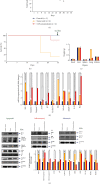A Novel Oral Astaxanthin Nanoemulsion from Haematococcus pluvialis Induces Apoptosis in Lung Metastatic Melanoma
- PMID: 32908627
- PMCID: PMC7471791
- DOI: 10.1155/2020/2647670
A Novel Oral Astaxanthin Nanoemulsion from Haematococcus pluvialis Induces Apoptosis in Lung Metastatic Melanoma
Abstract
Astaxanthin (AST) is a naturally occurring xanthophyll carotenoid having the potential to be used as an anticancer agent; however, the human body has a low bioavailability of AST due to its poor solubility in the water phase. Therefore, we applied D-α-tocopheryl polyethylene glycol succinate (TPGS) as an emulsifier and natural edible peanut oil to form a steady oil-in-water (O/W) nanoemulsion loaded with AST (denoted as TAP-nanoemulsion). TAP-nanoemulsions were stable without the droplet coalescence against thermal treatments (30-90°C), pH value changes (over a range of 2.0-8.0), and ionic strength adjustments (at NaCl concentrations of 100-500 mM) measured by dynamic light scattering (DLS). AST within TAP-nanoemulsion was released up to 80% in a simulated intestinal enzymatic fluid in vitro, and the overall recovery rate was fairly consistent in the Caco-2 cellular model. In order to further evaluate in vivo melanoma inhibitory experiments, we injected the fluorescent-stained B16F10 cells into female C57BL/6 mouse tail veins and treated TAP-nanoemulsion in an oral gavage. qRT-PCR and Western blot demonstrated that TAP-nanoemulsion triggered effectively the apoptosis pathway, including enhancements of cleaved caspase-3 and caspase-9, ataxia-telangiectasia mutated kinase (ATM), and p21WAF1/CIP1 (p21) and decreases of B-cell lymphoma 2 (Bcl-2); cyclins D, D1, and E; mitogen-activated protein kinase (MEK); extracellular signal-regulated kinases (ERK); nuclear factor κ-light-chain-enhancer of activated B cells (NF-κB); and matrix metallopeptidase-1 and metallopeptidase-9 (MMP-1 and MMP-9) in both gene and protein expressions. In conclusion, this study suggests that TAP-nanoemulsion with the oral treatment has a positive chemotherapy effect in melanoma with lung metastases in vivo. As far as we know, this is the first time to demonstrate that an antioxidant in nanoparticle administration cures lung metastatic melanoma.
Copyright © 2020 Hsing-Yu Haung et al.
Conflict of interest statement
The authors have no competing financial interests to declare.
Figures






Similar articles
-
Cellulose nanocrystals/nanofibrils loaded astaxanthin nanoemulsion for the induction of apoptosis via ROS-dependent mitochondrial dysfunction in cancer cells under photobiomodulation.Int J Biol Macromol. 2020 Apr 15;149:165-177. doi: 10.1016/j.ijbiomac.2020.01.243. Epub 2020 Jan 25. Int J Biol Macromol. 2020. PMID: 31987944
-
Systemic delivery of nanoparticle formulation of novel tubulin inhibitor for treating metastatic melanoma.Drug Deliv Transl Res. 2015 Jun;5(3):199-208. doi: 10.1007/s13346-015-0226-2. Drug Deliv Transl Res. 2015. PMID: 25924699 Free PMC article.
-
Nanoemulsion formulations for anti-cancer agent piplartine--Characterization, toxicological, pharmacokinetics and efficacy studies.Int J Pharm. 2016 Feb 10;498(1-2):12-22. doi: 10.1016/j.ijpharm.2015.11.045. Epub 2015 Nov 28. Int J Pharm. 2016. PMID: 26642946 Free PMC article.
-
Haematococcus astaxanthin: applications for human health and nutrition.Trends Biotechnol. 2003 May;21(5):210-6. doi: 10.1016/S0167-7799(03)00078-7. Trends Biotechnol. 2003. PMID: 12727382 Review.
-
Nanocarrier System: State-of-the-Art in Oral Delivery of Astaxanthin.Antioxidants (Basel). 2022 Aug 27;11(9):1676. doi: 10.3390/antiox11091676. Antioxidants (Basel). 2022. PMID: 36139750 Free PMC article. Review.
Cited by
-
Adipose-Derived Stem Cell-Incubated HA-Rich Sponge Matrix Implant Modulates Oxidative Stress to Enhance VEGF and TGF-β Secretions for Extracellular Matrix Reconstruction In Vivo.Oxid Med Cell Longev. 2022 Jan 17;2022:9355692. doi: 10.1155/2022/9355692. eCollection 2022. Oxid Med Cell Longev. 2022. PMID: 35082971 Free PMC article.
-
The Antitumour Mechanisms of Carotenoids: A Comprehensive Review.Antioxidants (Basel). 2024 Aug 30;13(9):1060. doi: 10.3390/antiox13091060. Antioxidants (Basel). 2024. PMID: 39334719 Free PMC article. Review.
-
Safety Assessment of 3S, 3'S Astaxanthin Derived from Metabolically Engineered K. marxianus.Antioxidants (Basel). 2022 Nov 18;11(11):2288. doi: 10.3390/antiox11112288. Antioxidants (Basel). 2022. PMID: 36421474 Free PMC article.
-
Carotenoids from Marine Microalgae as Antimelanoma Agents.Mar Drugs. 2022 Sep 29;20(10):618. doi: 10.3390/md20100618. Mar Drugs. 2022. PMID: 36286442 Free PMC article. Review.
-
Dihydroartemisinin enhances gefitinib cytotoxicity against lung adenocarcinoma cells by inducing ROS-dependent apoptosis and ferroptosis.Kaohsiung J Med Sci. 2023 Jul;39(7):699-709. doi: 10.1002/kjm2.12684. Epub 2023 Apr 14. Kaohsiung J Med Sci. 2023. PMID: 37057810 Free PMC article.
References
-
- Chou H.-Y., Lee C., Pan J.-L., et al. Enriched astaxanthin extract from Haematococcus pluvialis augments growth factor secretions to increase cell proliferation and induces MMP1 degradation to enhance collagen production in human dermal fibroblasts. International Journal of Molecular Sciences. 2016;17(6):955–967. doi: 10.3390/ijms17060955. - DOI - PMC - PubMed
-
- Chen Y. T., Kao C. J., Huang H. Y., et al. Astaxanthin reduces MMP expressions, suppresses cancer cell migrations, and triggers apoptotic caspases of in vitro and in vivo models in melanoma. Journal of Functional Foods. 2017;31:20–31. doi: 10.1016/j.jff.2017.01.005. - DOI
-
- Pan J.-L., Wang H.-M., Chen C.-Y., Chang J.‐. S. Extraction of astaxanthin from Haematococcus pluvialis by supercritical carbon dioxide fluid with ethanol modifier. Engineering in Life Sciences. 2012;12(6):638–647. doi: 10.1002/elsc.201100157. - DOI
MeSH terms
Substances
LinkOut - more resources
Full Text Sources
Other Literature Sources
Medical
Research Materials
Miscellaneous

